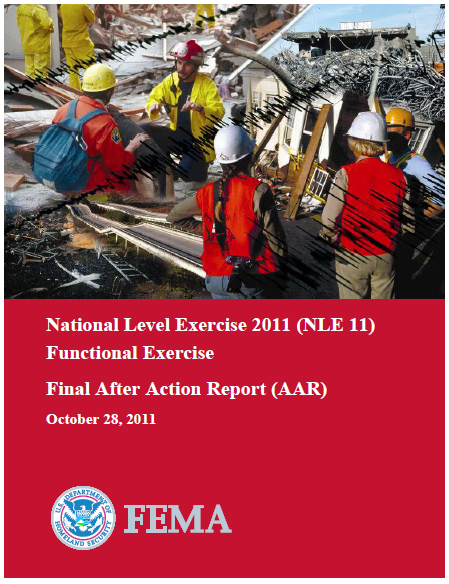National Level Exercise 2011 (NLE 11) Functional Exercise Final After Action Report (AAR)
- 81 pages
- For Official Use Only
- October 28, 2011
On Monday, May 16, 2011, thousands of players across the United States received notification of a simulated catastrophic earthquake in the New Madrid Seismic Zone (NMSZ), officially kicking off the National Level Exercise 2011 (NLE 11) functional exercise. From May 16–19, 2011, Federal, state, regional, local, international, nongovernmental, and private sector partners participated in the exercise, the capstone event of a White House-directed, congressionally mandated cycle of planning and preparedness events. Notably, exercise activities were carefully balanced with ongoing efforts to respond to and recover from real-world flooding and tornado-related disasters in the Southern and Central United States. Although some partners, including the four states in FEMA Region IV (Alabama, Kentucky, Mississippi, and Tennessee), had to reduce their participation in NLE 11 due to these events, their actions, requests, and decisions were simulated to allow for robust and realistic exercise play. Simultaneously conducting NLE 11 and managing real-world disasters resulted in a realistic “worst-case scenario.” Consequently, players were able to test the Nation’s ability to respond to several devastating events, strengthening the country’s preparedness through their efforts.
…
Participating Organizations
The exercise took place at venues in the National Capital Region and across the Central United States, with over 10,000 Federal, state, regional, local, international, nongovernmental, and private sector players at more than 135 sites across the country. In addition, over 7,800 individuals from the private sector and non-profit community participated virtually. Participation included Federal departments and agencies (D/As), four FEMA regions (IV, V, VI, and VII), and eight states (Alabama, Arkansas, Illinois, Indiana, Kentucky, Mississippi, Missouri, and Tennessee), international, private sector, and nongovernmental partners. Federal players were located in their internal EOCs, at the National Response Coordination Center (NRCC), the appropriate Regional Response Coordination Center (RRCC), and in the states (at EOCs, Initial Operating Facilities [IOFs] and Joint Field Offices [JFOs]). The list of national participating D/As is shown in Appendix B.4
International Play
International players included Canada, Chile, Israel, the European Union, Mexico, Russia, and Sweden. Key issues, such as the use of international Urban Search and Rescue (US&R) teams and medical personnel, were raised, and will be discussed in this AAR.
Full-Scale Elements and Linked Exercises
NLE 11 was an operations-based, functional exercise, with some localized full-scale elements. Examples included the following:
• Arkansas School Collapse Earthquake event: a full-scale rescue mission;
• Federal, state and international US&R missions at Muscatatuck Urban Training Complex (MUTC) in Indiana.In addition, the Department of Defense (DoD)-sponsored Ardent Sentry 11 exercise, which focused on Defense Support of Civil Authorities (DSCA), included several components linked to NLE 11:
• Vigilant Guard: a National Guard exercise conducted in multiple states to assess the National Guard’s ability to assist state and local agencies in emergency response, coordination, and collaboration;
• Noble Lifesaver/Ultimate Caduceus: a joint Department of Health and Human Services (HHS) and U.S. Transportation Command (USTRANSCOM) full-scale patient movement and tracking exercise in Missouri;
• Turbo Challenge: a USTRANSCOM field training and command post patient movement exercise conducted in Missouri in coordination with the DHS, the Joint Chiefs of Staff, and U.S. Northern Command (USNORTHCOM);
• Positive Response: a Joint Staff “umbrella” exercise and mechanism for the Office of the Secretary of Defense (OSD), Joint Staff, and Services participation.Number of Participants (approximate)
• Players: 10,270
• National-level controllers/simulators: 500
• National-level evaluators: 70
• Observers: 380
• Virtual engagement: 7,800

